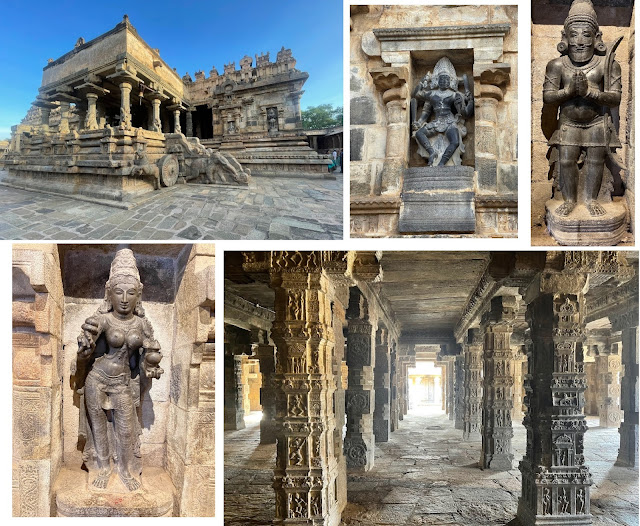DARASURAM - Outstanding !
Darasuram is one of the three " Great Living Chola Temples " given the UNESCO World Heritage Site tag for being the repository of glorious Chola Art and Architecture .
The huge Airavateshwara Complex , built by Rajaraja II ( 12th Cent), is an outstanding open museum which demands that we spend at least two whole days examining and admiring each and every block of stone, to do any justice to its grandeur. The innumerable stone figures populating this exquisite storehouse of religious art each have individuality in expressions and demeanor.
Each visit is a voyage of discovery for everytime, some new detail comes to notice. For one thing, since those bad old days of shameful neglect , something has been done to renovate and spruce up the monuments in the complex. That is a great Plus. Consequently, its rating in the tourist circuit has gone up, so that more and more people are getting to appreciate the treasures it holds. However the minus points is that, heavy influx of visitors also gives rise to the problem of insensitive picnickers and vandals. And to protect the art , the guardians have had to put up ugly metal railings , thereby marring the wholesome effect for true lovers of art. This is especially the case with the unique Balipeetam that has stone steps that ring out in seven different tones ( swaras) when struck . The music of these stones have been silenced forever with a bulky grill !
Words fail to express fully the wonder and awe that the Darasuram complex inspires . The Darasuiram sculptures of the deities is often held up as the Benchmark for Chola artistic excellence . While the building is constructed of a pale granite , the sculptures in the niches (Koshta Murtis) are of a smooth black stone . The over all effect of these dark hued figures within a paler box frame is very eye catching .
Some paintings are seen on the bare areas of the walls , mostly red, russet, white and ochre in colour . They are all faded to varying degrees , some marred by seepage and grime . These are not Chola murals , but done during the Vijayanagara renaissance.
The main Vimana is 85 ft. high. The ornate mantapa in front is modeled like a horse chariot , complete with horses and wheels.
During one of the trips , sometime in the 1980s , had the good fortune of meeting this old gentleman , a voluntary and very knowledgeable Guide, who took great pride and pains to point out details to us. He was fluent in 5 languages( including English and French) and was a repository of stories , both pertaining to the temple and to contemporary local politics !
The main Vimana is 85 ft. high. The ornate mantapa in front is modeled like a horse chariot , complete with horses and wheels.
On the adhistana are found miniature bas relief carving narrating the stories of some of the Nayanars (Shaiva saints) . Also numerous are Dancers demonstrating various Karanas , thou not the entire repertoire .
Though in worship, the temple timings are erratic. Because of lack of regular visitors, the temple is locked up as soon as morning rituals are done. Thankfully, the ASI guard is helpful in ringing for the person who holds the keys, when requested.
During one of the trips , sometime in the 1980s , had the good fortune of meeting this old gentleman , a voluntary and very knowledgeable Guide, who took great pride and pains to point out details to us. He was fluent in 5 languages( including English and French) and was a repository of stories , both pertaining to the temple and to contemporary local politics !




